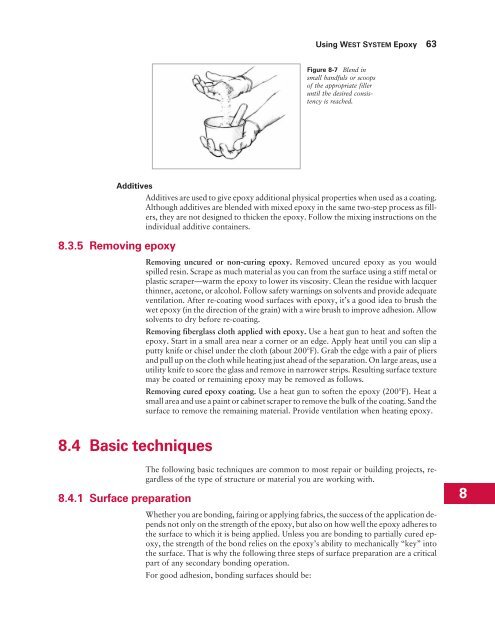Wooden Boat Restoration Repair - WEST SYSTEM Epoxy
Wooden Boat Restoration Repair - WEST SYSTEM Epoxy
Wooden Boat Restoration Repair - WEST SYSTEM Epoxy
You also want an ePaper? Increase the reach of your titles
YUMPU automatically turns print PDFs into web optimized ePapers that Google loves.
Additives<br />
Additives are used to give epoxy additional physical properties when used as a coating.<br />
Although additives are blended with mixed epoxy in the same two-step process as fillers,<br />
they are not designed to thicken the epoxy. Follow the mixing instructions on the<br />
individual additive containers.<br />
8.3.5 Removing epoxy<br />
8.4 Basic techniques<br />
8.4.1 Surface preparation<br />
Using <strong>WEST</strong> <strong>SYSTEM</strong> <strong>Epoxy</strong> 63<br />
Figure 8-7 Blend in<br />
small handfuls or scoops<br />
of the appropriate filler<br />
until the desired consistency<br />
is reached.<br />
Removing uncured or non-curing epoxy. Removed uncured epoxy as you would<br />
spilled resin. Scrape as much material as you can from the surface using a stiff metal or<br />
plastic scraper—warm the epoxy to lower its viscosity. Clean the residue with lacquer<br />
thinner, acetone, or alcohol. Follow safety warnings on solvents and provide adequate<br />
ventilation. After re-coating wood surfaces with epoxy, it’s a good idea to brush the<br />
wet epoxy (in the direction of the grain) with a wire brush to improve adhesion. Allow<br />
solvents to dry before re-coating.<br />
Removing fiberglass cloth applied with epoxy. Use a heat gun to heat and soften the<br />
epoxy. Start in a small area near a corner or an edge. Apply heat until you can slip a<br />
putty knife or chisel under the cloth (about 200°F). Grab the edge with a pair of pliers<br />
and pull up on the cloth while heating just ahead of the separation. On large areas, use a<br />
utility knife to score the glass and remove in narrower strips. Resulting surface texture<br />
may be coated or remaining epoxy may be removed as follows.<br />
Removing cured epoxy coating. Use a heat gun to soften the epoxy (200°F). Heat a<br />
small area and use a paint or cabinet scraper to remove the bulk of the coating. Sand the<br />
surface to remove the remaining material. Provide ventilation when heating epoxy.<br />
The following basic techniques are common to most repair or building projects, regardless<br />
of the type of structure or material you are working with.<br />
Whether you are bonding, fairing or applying fabrics, the success of the application depends<br />
not only on the strength of the epoxy, but also on how well the epoxy adheres to<br />
the surface to which it is being applied. Unless you are bonding to partially cured epoxy,<br />
the strength of the bond relies on the epoxy’s ability to mechanically “key” into<br />
the surface. That is why the following three steps of surface preparation are a critical<br />
part of any secondary bonding operation.<br />
For good adhesion, bonding surfaces should be:<br />
8
















